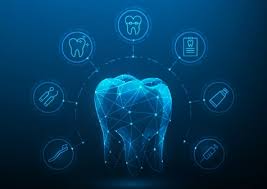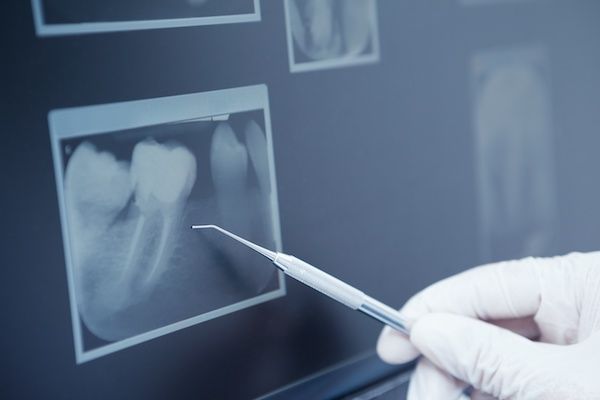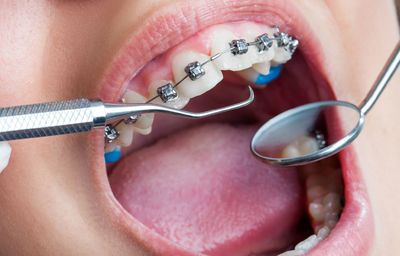Integration of AI in Dentistry
Srija S • 2024-03-06
The field of dentistry is on the cusp of a revolution fuelled by the ever-evolving power that we refer to as Artificial Intelligence (AI). AI is already making significant contributions to the various areas of dentistry, from diagnosis and treatment plans to admin tasks and patient education. In this article I will be exploring the current state of AI in dentistry, its benefits, limitations and the ethical considerations.
Image Analysis and Radiography
Image analysis and AI radiography seems to be one of the most promising applications of AI. Dental X-rays, intraoral scans and panoramic scans hold a wealth of information about a patient’s oral and dental health. AI powered softwares can analyse these images with incredible speed and accuracy and identify oral health issues like periodontal disease, dental caries and cancerous lesions. Recent studies have stated that these AI algorithms are on par with, and in some cases even exceed trained dentists in detecting dental caries. This allows dentists to identify these oral health issues earlier and take the necessary precautions and improve patient outcomes.
The primary advantage of AI application in radiography is that it can process and analyse large amounts of data quickly and accurately. Traditional radiographic analysis depends heavily on the expertise of the dental professionals which can vary between different professionals. AI systems, however, are trained on vast amounts of data and can provide an accurate and precise analysis. This leaves little room for human error and makes sure that potential oral health issues are identified. Furthermore, AI can highlight subtle details that could’ve very easily been overlooked by a human dental professional. Attention to detail is crucial for identifying diseases at early stages. Early intervention can reduce treatment costs and complexity.
While AI is remarkably fast and accurate it doesn’t mean it’s error-free. There is always a risk of the scan or x-ray image being misinterpreted by the AI software. However, since AI is still relatively new, its full potential is yet to be established. AI can be trained to be more accurate and reliable over time but for now dentists should be careful not to rely too much on AI.
The utilisation of AI in dental radiography raised concerns related to ethics and employment. When AI becomes proficient in analysing x-ray images and scans more accurately there is a risk of AI powered softwares displacing human radiography specialists. This could lead to job losses and a shift in the workplace with more AI centric roles.
AI powered notetaking
AI can also revolutionize notetaking in the field of dentistry and has several advantages. Firstly, it allows dentists to focus on reassuring and interacting with the patient instead of focusing on notetaking. The automated transcription process fosters better communication and understanding between the patient
The utilisation of AI systems in the transcription process does raise concerns regarding patient privacy, confidentiality and the reliability of the AI powered software. There may be cases where a patient isn’t informed about the fact that AI is being used in the process of forming a diagnosis as there aren’t any laws regarding AI so dental practices may not feel obligated to let the patient know that AI is being used in their diagnosis which raises concerns regarding patient consent and confidentiality. Establishment of patient data and security is paramount for patients to maintain trust in both the dentist and AI systems.
Additionally, there is a risk of AI misinterpreting speech as people tend to speak at different proficiencies which could cause misunderstandings for the patient. Errors in AI powered transcription softwares can have significant implications in how oral care is delivered as inaccuracies in the patient’s medical records can lead to incorrect treatment plans which compromise patient safety. Therefore, it is crucial for dental professionals to monitor and verify AI generated transcripts to ensure their accuracy.
Older patients or patients less familiar with AI may not comfortable with AI and it's usage in a dental setting. Building trust and understanding around AI technologies is crucial to ensuring patient acceptance and cooperation.
AI in Orthodontic Treatment Planning.
Orthodontic treatment planning involves significant analysis and precision, areas where AI can be particularly beneficial. AI can optimize analytics to predict the size of impacted teeth and the necessity for extractions. By providing a starting point and a target endpoint, AI can calculate the best path for teeth to move, saving both time and potentially reducing costs for patients.
AI can significantly enhance the efficiency and accuracy of orthodontic treatment planning. Traditional methods of planning tooth movements can be time-consuming and complex, requiring detailed analysis and manual calculations. AI can automate these processes, providing faster and more accurate treatment plans.
Moreover, AI can customize treatment plans to achieve better outcomes with fewer adjustments. This optimization can reduce the number of visits patients need, and thus lowering treatment costs and improving patient convenience. AI can also provide simulations of treatment outcomes, helping patients understand the expected results and setting realistic expectations.
Despite these advantages, reliance solely on AI for treatment planning poses risks. AI might incorrectly predict which tooth requires extraction, leading to severe health impacts and legal implications. Ensuring that orthodontists re-check AI-generated plans is crucial for maintaining accuracy. Human oversight is essential to validate AI recommendations and adjust based on clinical expertise and patient-specific factors.
Additionally, the cost of AI programs could exacerbate inequalities in dental care, as not all practices can afford these advanced technologies. Smaller or underfunded dental practices might struggle to invest in AI systems, potentially widening the gap between different socioeconomic groups in access to advanced orthodontic care.
The integration of AI in orthodontics also raises ethical and social considerations. It is essential to ensure that AI systems are trained on diverse and representative datasets to avoid biases and ensure equitable treatment outcomes. AI should be designed to complement, not replace, the expertise of orthodontists, maintaining the human touch and personalized care that are fundamental to dentistry.
AI in Dental Technology
AI's role in enhancing dental technology extends to creating better quality materials and assisting with robotics in procedures like drilling and cleaning. AI can also aid in quality control, such as scanning dental prosthetics for defects.
AI can significantly improve the quality and precision of dental materials. For example, AI algorithms can analyse the properties of materials used in dental prosthetics, ensuring they meet high standards of durability and biocompatibility. This analysis can lead to the development of superior dental materials, enhancing patient outcomes and satisfaction.
In robotics, AI can assist dentists with precise and consistent drilling and cleaning procedures. Robotic systems can perform repetitive tasks with high accuracy, reducing the risk of human error and improving the overall quality of dental procedures. AI-assisted robotics can also reduce the physical strain on dentists, allowing them to focus on more complex and critical aspects of patient care.
However, AI lacks the sensitivity to patient pain and may not be as reassuring as a human dentist, potentially exacerbating dental anxiety in some patients. Ensuring that AI systems can respond appropriately to patient discomfort and distress is crucial to maintaining patient trust and comfort.
Furthermore, the cost of implementing AI and robotics in dental practices can be prohibitive. Smaller practices may find it challenging to invest in these technologies, potentially widening disparities in access to advanced dental care.
The use of AI in dental technology also raises ethical considerations around patient consent and data privacy. Patients should be informed when AI and robotic systems are used in their treatment, and their consent should be obtained. Ensuring robust data protection measures are in place is crucial to maintaining patient trust and confidentiality.
AI in Dental Treatment Planning and Admin Roles
Beyond clinical applications, AI can perform administrative tasks in dental practices, such as managing appointments and patient records. AI can also be used in preventive care, educating children on proper brushing techniques and assisting with real-time translation for non-native speakers. Additionally, AI can create visual simulations of treatment outcomes, enhancing patient understanding and satisfaction.
AI can significantly enhance the efficiency of administrative tasks in dental practices. For example, AI systems can manage appointment scheduling, ensuring optimal utilization of dental practice resources and reducing waiting times for patients. AI can also automate patient record management, ensuring that all relevant information is accurately recorded and easily accessible.
In preventive care, AI can play a crucial role in patient education. AI-powered applications can provide personalized brushing and flossing instructions, helping patients maintain better oral hygiene. AI can also assist with real-time translation for non-native speakers, ensuring effective communication and understanding between dentists and patients.
However, the integration of AI in administrative and preventive care is not without challenges. The cost of implementing AI systems can be significant, potentially limiting their adoption in smaller practices. Additionally, there are concerns about data privacy and security, particularly around the management and storage of patient information.
Moreover, the use of AI in patient education and communication must be carefully managed to ensure that the information provided is accurate and appropriate. AI systems should be regularly updated and validated to ensure they provide reliable and relevant advice.
The use of AI in administrative and preventive care also raises ethical considerations around patient consent and data privacy. Patients should be informed when AI systems are used in their care, and their consent should be obtained. Ensuring robust data protection measures are in place is crucial to maintaining patient trust and confidentiality.
Ethical Considerations and Future of AI in Dentistry
While AI holds great promise for dentistry, ethical considerations must be addressed. Ensuring patient privacy and data security is paramount, as is maintaining transparency about AI usage in dental practices. Furthermore, AI should complement rather than replace human dentists. Dentistry is fundamentally a career built on empathy and patient interaction, aspects that AI cannot replicate.
One of the primary ethical concerns around AI in dentistry is patient privacy and data security. AI systems rely on large volumes of patient data for training and operation, raising concerns about the confidentiality and security of this data. It is essential to implement robust data protection measures to ensure that patient information is securely stored and managed.
Another ethical concern is the transparency of AI usage. Patients should be informed when AI is used in their care, and their consent should be obtained. Ensuring transparency and patient consent is crucial to maintaining trust in AI systems.
AI should be designed to complement, not replace, human dentists. Dentistry is fundamentally a career built on empathy and patient interaction, aspects that AI cannot replicate. The future of dentistry lies in collaboration between AI and dental professionals, enhancing the field while preserving its core values.
The cost of implementing AI systems can be significant, potentially exacerbating socioeconomic inequities in access to advanced dental care. It is essential to develop strategies to ensure that the benefits of AI are accessible to all patients, regardless of socioeconomic status.
AI systems must be trained on diverse and representative datasets to avoid biases and ensure equitable treatment outcomes. Ensuring equity in AI training is crucial to maintaining fairness and reliability in AI-assisted dental care.
Conclusion:
AI has the potential to revolutionize dentistry, and offers numerous benefits in diagnostics, treatment planning, and administration. However, its integration must be carefully managed to address ethical concerns, ensure accuracy, and maintain the essential human elements of dental care. The future of dentistry lies in collaboration between AI and dental professionals, enhancing the field while preserving its core values. As AI continues to evolve, it will undoubtedly play an increasingly significant role in shaping the future of dental care, improving patient outcomes, and advancing the practice of dentistry.
See More Posts
Copyright © 2021 Govest, Inc. All rights reserved.






